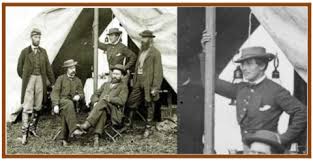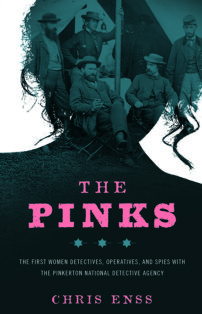Enter to win a copy of
The Pinks:
The First Women Detectives, Operatives, and Spies with the Pinkerton National Detective Agency

The person holding onto the tent pole has been mistaken as Kate Warne. No photo exists of Kate.
The depot of the Philadelphia, Wilmington and Baltimore Railroad in Philadelphia was strangely bustling with an assortment of customers on the evening of February 22, 1861. Businessmen dressed in tailcoats, high-waisted trousers, and elaborate cravats milled about with laborers adorned in faded work pants, straw hats, and long dusters. Ladies wearing long, flouncy, bell-shaped dresses with small hats topped with ribbon streamers of blue, gold, and red mingled with women in plain brown skirts, white, leg-o- mutton sleeve blouses and shawls. Some of the women traveled in pairs conversing in low voices as they walked from one side of the track to the other. Most everyone carried carpet bags or leather valises with them.
The depot was the hub of activity; parent and child, railroad employees, and young men in military uniforms made their way with tickets in hand and destinations in mind. Among the travelers were those who were content to remain in one place either on a bench reading a paper or filling the wait time knitting. Some frequently checked their watches, and others drummed their fingers on the wooden armrests of their seats. There was an air of general anticipation. It was chilly and damp, and restless ticket holders studied the sky for rain. In the far distance, thunder could be heard rumbling.
At 10:50 in the evening, an engine and a few passenger cars pulled to a stop at the depot, and a conductor disembarked. The man was pristinely attired and neatly groomed. He removed a stopwatch from his pocket and cast a glance up and down the tracks before reading the time. The conductor made eye contact with a businessman standing near the ticket booth who nodded ever so slightly. The businessman adjusted the hat on his head and walked to the far end of the depot where a freight loader was pushing a cart full of luggage toward the train. The freight man eyed the businessman as he passed by, and the businessman turned and headed in the opposite direction. Something was about to happen, and the three individuals communicating in a minimal way were involved.
Three, well-built men in gray and black suits alighted from one of the cars as the freight man approached. One of the men exchanged pleasantries with the baggage handler as he lifted the suitcases onto the train, and the two other men took in the scene before them. Somewhere out of the shadows of their poorly lit platform, a somberly dressed, slender woman emerged. At first glance she appeared to be alone. She stood quietly waiting for the freight man to load the last piece of luggage. When he had completed the job and was returning to the ticket office, she walked briskly toward the train.
The woman’s hand and wrist were hooked in the arm of a tall man, dark and lanky, wrapped in a heavy, traveling shawl. He wore a broad-brimmed, felt hat low on his head and was careful to look down as he hurried along. When he and his escort reached the car, the woman presented her tickets to the conductor who arrived at the scene at the same time. “My invalid brother and I are attending a family party,” she volunteered. After examining the tickets for a moment, the conductor stepped aside to allow the pair to board. Protectively and tenderly, the woman took her brother’s arm and helped him to the stairs leading up the train. With an hint of reluctance, the lean, angular man climbed aboard.

To learn more about Kate Warne and the other
women Pinkerton agents read
The Pinks:
The First Women Detectives, Operatives, and Spies with the Pinkerton National Detective Agency.

